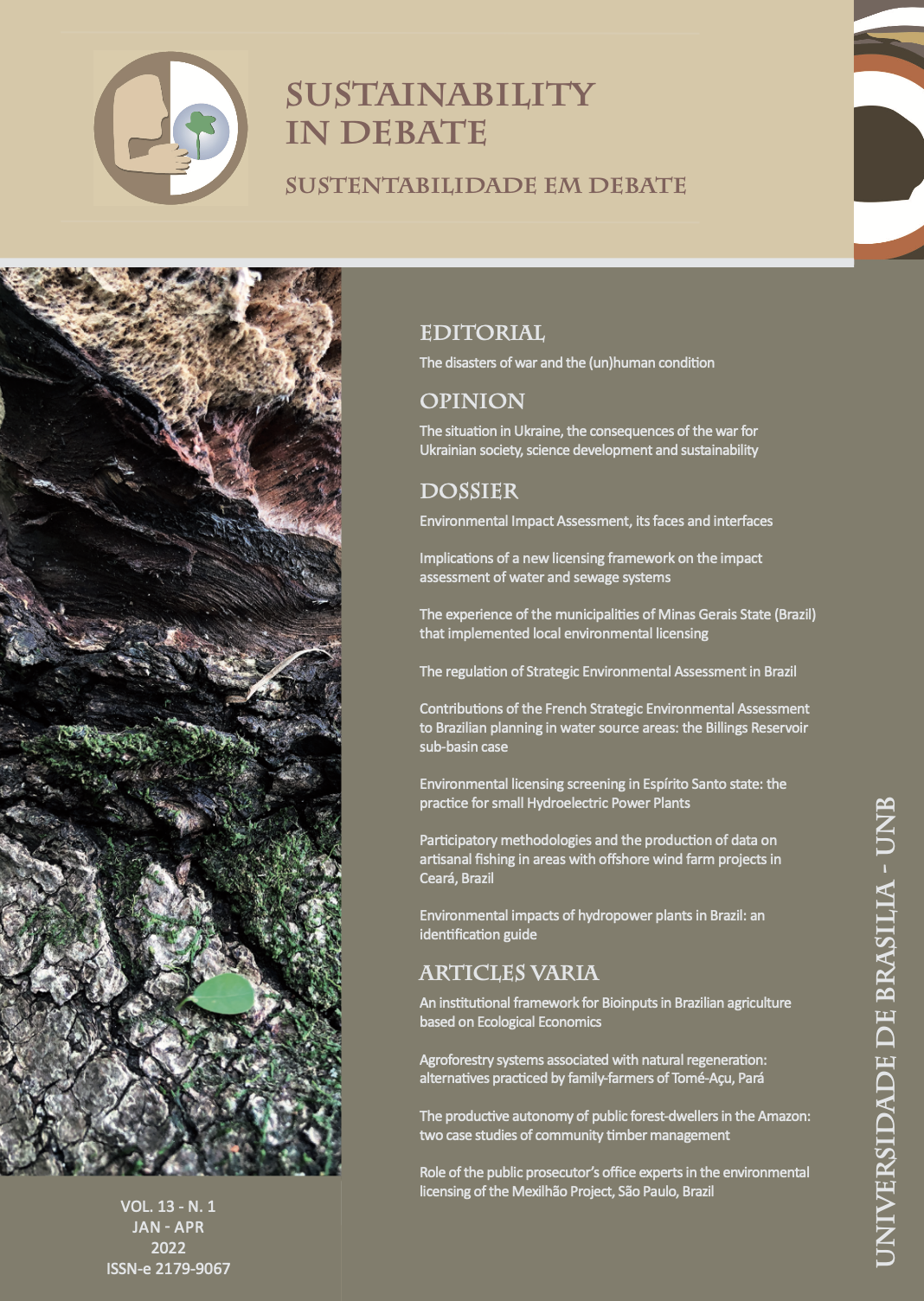Agroforestry systems associated with natural regeneration: alternatives practiced by family-farmers of Tomé-Açu, Pará
DOI:
https://doi.org/10.18472/SustDeb.v13n1.2022.40855Palavras-chave:
Species richness. Species diversity. Floristics. Amazon.Resumo
The objective of this article was to analyze the benefits of Agroforestry Systems (AFSs) association with natural regeneration promoted by family farmers of Tomé-Açu, Pará, Brazil. Based on 46 previous interviews with family farmers, 12 of them were selected due to the presence of AFSs with different levels of tree species diversity, in which richness and diversity of tree species were taken into account. In addition, the measurement of the floristic variables was carried out. Results showed that 17% of the AFSs have natural regeneration corridors. This type of AFS has high species richness and diversity (Shannon-Weaner = 2.5), and its main characteristic is the presence of regeneration corridors of secondary forests. Therefore, farmers make production and forest regeneration compatible, and: a) maintain in their AFSs environmental services provided by regenerated secondary forests, b) ensure food security for their families, and c) they may have financial incomes from selling AFS products.
Downloads
Referências
ALTIERI, M. A. The ecological role of biodiversity in agroecosystems. In: Invertebrate biodiversity as bioindicators of sustainable landscapes. Elsevier, 1999. p. 19-31.
ALTIERI, M. A.; NICHOLLS, C. I. Agroecology: Challenges and opportunities for farming in the Anthropocene. Ciencia e Investigación Agraria: revista latinoamericana de ciencias de la agricultura, v. 47, n. 3, p. 204-215, 2020.
BOLFE, É. L.; BATISTELLA, M. Análise florística e estrutural de sistemas silviagrícolas em Tomé-Açu, Pará. Pesquisa Agropecuária Brasileira, v. 46, p. 1139-1147, 2011.
BRASIL. Lei Nº 11.326, de 24 de julho de 2006. Art. 3º. Available in: http://www.planalto.gov.br/ccivil_03/_ato2004-2006/2006/lei/l11326.htm. Access on: 31 jan. 2022.
CARNEIRO, R. DO V.; NAVEGANTES-ALVES, L. DE F. A diversidade de experiências de recuperação florestal praticada por agricultores familiares do Nordeste do Pará. Geoambiente On-line, n. 35, p. 293-314, 2019.
CHAYANOV, A. V. La organización de la unidad económica campesina. Buenos Aires: Nueva Visión, v. 2, 1974.
CHAZDON, R. L. Second Growth: the promise of tropical forest regeneration 485. An Age of Deforestation, 2014.
CHAZDON, R. L.; GUARIGUATA, M. R. Natural regeneration as a tool for large?scale forest restoration in the tropics: prospects and challenges. Biotropica, v. 48, n. 6, p. 716-730, 2016.
DOS SANTOS, V. A. H. F.; FERREIRA, M. J. Initial establishment of commercial tree species under enrichment planting in a Central Amazon secondary forest: effects of silvicultural treatments. Forest Ecology and Management, v. 460, p. 117822, 2020.
DUBOIS, J. C. L. A importância de espécies perenes de maior valor econômico em sistemas agroflorestais. In: SILVA, I. C. Sistemas Agroflorestais: conceitos e métodos. Itabuna: SBSAF, 2013.
ELIAS, F. et al. Assessing the growth and climate sensitivity of secondary forests in highly deforested Amazonian landscapes. Ecology, v. 101, n. 3, p. e02954, 2020.
GEERTZ, C. A religião como sistema cultural. A interpretação das culturas, v. 2, 1989.
INSTITUTO BRASILEIRO DE GEOGRAFIA E ESTATÍSTICA. 2010, 2015, 2018. Available in: https://cidades.ibge.gov.br/brasil/pa. Access on: 23 nov. 2018.
INSTITUTO BRASILEIRO DE GEOGRAFIA E ESTATÍSTICA. Produção de extração vegetal e da silvicultura. Rio de Janeiro, RJ: Ministério do Planejamento, Orçamento e Gestão, Brasil, 2016. Available in: https://www.ibge.gov.br/estatisticas/economicas/agricultura-e-pecuaria/9105-producao-da-extracao-vegetal-e-da-silvicultura.html?=&t=series-historicas. Access on: 23 nov. 2018.
MAGURRAN, A. E. Ecological diversity and its measurement. Princeton University Press, 1988.
MANN, P. H.; VELHO, O. A. Métodos de investigação sociológica. 1969.
MARTINS, P. S. Dinâmica evolutiva em roças de caboclos amazônicos. Estudos Avançados, v. 19, p. 209-220, 2005.
MILLER, R. P. Construindo a complexidade: o encontro de paradigmas. In: PORRO, A. Alternativa agroflorestal na Amazônia em transformação. Brasília-DF: Embrapa Informação Tecnológica, 2009.
NAIR, P. K. R. An introduction to agroforestry. Springer Science & Business Media, 1993.
ODUM, E. P. Fundamentos de Ecologia. 7. ed. 2004.
OSTY, P. L. L'entreprise agricole dans son environnement: propositions pour structurer une evaluation de la strategie. 1978.
PIAZZA, G. E. et al. Regeneração natural de espécies madeireiras na floresta secundária da Mata Atlântica. Advances in Forestry Science, v. 4, n. 2, p. 99-105, 2017.
PIZARRO, A. Amazônia: as vozes do rio. Imaginário e modernização. Belo Horizonte: Editora UFMG, 2012.
PLOEG, JAN D. VAN DER et al. Dez qualidades da agricultura familiar. 2014.
POMPEU, G. DO S. DOS S.; KATO, O. R.; ALMEIDA, R. H. C. Percepção de agricultores familiares e empresariais de Tomé-Açu, Pará, Brasil sobre os Sistemas de Agrofloresta. Sustainability in Debate, v. 8, n. 3, 2017.
POORTER, L. et al. Biomass resilience of Neotropical secondary forests. Nature, v. 530, n. 7589, p. 211-214, 2016.
SCHWARTZ, G. et al. Post-harvesting silvicultural treatments in logging gaps: a comparison between enrichment planting and tending of natural regeneration. Forest Ecology and Management, v. 293, p. 57-64, 2013.
SEBILLOTTE, M. Agronomie et agriculture. Essai d’analyse des tâches de l’agronome. Cahiers de L’Orstom, v. 24, p. 3-25, 1974.
SILVA, I. C. Sistemas Agroflorestais: conceitos e métodos. Itabuna: SBSAF, 2013.
STRATE, M. F. et al. Sistemas agroflorestais: agrobiodiversidade, soberania, segurança alimentar e nutricional na promoção de saúde frente a pandemia da Covid-19. Cadernos de Agroecologia, v. 15, n. 4, 2020.
TAFNER JR, A. W.; SILVA, F. C. Colonização japonesa, história econômica e desenvolvimento regional do Estado do Pará. Novos cadernos Naea, v. 13, n. 2, 2011.
TEIXEIRA, H. M. et al. Linking vegetation and soil functions during secondary forest succession in the Atlantic forest. Forest Ecology and Management, v. 457, p. 117696, 2020.
VEENHOVEN, R. El estudio de la satisfacción con la vida. Intervención Psicosocial. Erasmo Universidad Rotterdam, v. 3, 1994.
VEENHOVEN, R. Healthy happiness: effects of happiness on physical health and the consequences for preventive health care. Journal of happiness studies, v. 9, n. 3, p. 449-469, 2008.
VIANA, V. M.; DUBOIS, J. C. L.; ANDERSON, A. B. Manual agroflorestal para a Amazônia. Rio de Janeiro: Rebraf, 1996.
VIEIRA, D. L. M. et al. Avaliação de indicadores da recomposição da vegetação nativa no Distrito Federal e em Mato Grosso. Embrapa Recursos Genéticos e Biotecnologia. Nota Técnica/Nota Científica (ALICE), 2018.
VIEIRA, I. C. G.; GARDNER, T. A. Florestas secundárias tropicais: ecologia e importância em paisagens antrópicas. Boletim do Museu Paraense Emílio Goeldi-Ciências Naturais, v. 7, n. 3, p. 191-194, 2012.
VINUTO, J. A amostragem em bola de neve na pesquisa qualitativa: um debate em aberto. Temáticas, v. 22, n. 44, p. 203-220, 2014.
WANDERLEY, M. DE N. B. Raízes históricas do campesinato brasileiro. Agricultura familiar: realidades e perspectivas, v. 3, p. 21-55, 1996.
WOORTMANN, E. F. O saber camponês: práticas ecológicas tradicionais e inovações. Diversidade do campesinato: expressões e categorias, v. 2, p. 119-129, 2009.
YAMADA, M.; GHOLZ, H. L. An evaluation of agroforestry systems as a rural development option for the Brazilian Amazon. Agroforestry Systems, v. 55, n. 2, p. 81-87, 2002.
Downloads
Publicado
Versões
- 2022-04-29 (2)
- 2022-04-29 (1)
Como Citar
Edição
Seção
Licença
Copyright (c) 2022 Sustainability in Debate

Este trabalho está licenciado sob uma licença Creative Commons Attribution-NonCommercial-NoDerivatives 4.0 International License.
A submissão de trabalho(s) científico(s) original(is) pelos autores, na qualidade de titulares do direito de autor do(s) texto(s) enviado(s) ao periódico, nos termos da Lei 9.610/98, implica na cessão de direitos autorais de publicação impressa e/ou digital à Revista Sustentabilidade em Debate do(s) artigo(s) aprovado(s) para fins da publicação, em um único número da Revista, autorizando-se, ainda, que o(s) trabalho(s) científico(s) aprovado(s) seja(m) divulgado(s) gratuitamente, sem qualquer tipo de ressarcimento a título de direitos autorais, por meio do site da Revista, para fins de leitura, impressão e/ou download do arquivo do texto, a partir da data de aceitação para fins de publicação. Portanto, os autores ao procederem a submissão do(s) artigo(s) Revista, e, por conseguinte, a cessão gratuita dos direitos autorais relacionados ao trabalho científico enviado, têm plena ciência de que não serão remunerados pela publicação do(s) artigo(s) no periódico.
A Revista encontra-se licenciada sob uma Licença Creative Commons Atribuição-NãoComercial-SemDerivações (Proibição de Realização de Obras Derivadas) 3.0 Brasil, para fins de difusão do conhecimento científico, conforme indicado no sítio da publicação, que permite o compartilhamento do texto e o reconhecimento de sua autoria e publicação original nesta revista.
Os autores têm permissão para assumir contratos adicionais separadamente, para distribuição não-exclusiva dos trabalhos publicados na Revista Sustentabilidade em Debate (por exemplo, em um capítulo de livro), desde que seja assinalado que os textos foram originalmente publicados nesta revista e que seja mencionado o DOI correspondente. Os autores têm permissão e são estimulados a publicar e distribuir o seu texto online, após a publicação (por exemplo, em repositórios institucionais ou nas suas páginas pessoais).
Os autores declaram expressamente concordar com os termos da presente Declaração de Direito Autoral, que se aplicará a submissão caso seja publicada por esta Revista.






